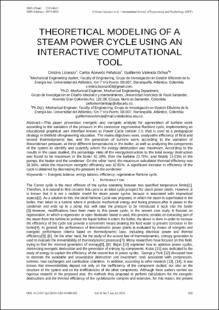Mostrar el registro sencillo del ítem
Theoretical modeling of a steam power cycle using an interactive computational tool
| dc.contributor.author | Lizarazo Bohórquez, Cristina | |
| dc.contributor.author | Acevedo Peñaloza, Carlos Humberto | |
| dc.contributor.author | Valencia Ochoa, Guillermo | |
| dc.date.accessioned | 2021-12-12T16:17:09Z | |
| dc.date.available | 2021-12-12T16:17:09Z | |
| dc.date.issued | 2018-07 | |
| dc.identifier.uri | http://repositorio.ufps.edu.co/handle/ufps/6380 | |
| dc.description.abstract | This paper presentsan energetic and exergetic analysis for ageneration of turbine work according to the variation of the pressure in the condenser regenerative Rankine cycle, implementing an educational graphical user interface known as Power Cycle version 2.0; that is used as a pedagogical strategy in thefield ofengineering education. The mains objectives were, analyzethe efficiency of first and second thermodynamic law, and the generation of turbine work according to the variation of thecondenser pressure, at three different temperatures in the boiler, as well as analyzing the components of the system to identify and quantify where the exergy destruction was maximum. According to the results in the cases studied, the percentage ratio of the exergydestruction to the total exergy destruction was found to be maximum in the boiler 62.18%, then the turbine 22.79%, and finally 15.03% in the pumps, the heater and the condenser. On the other hand, the maximum calculated thermal efficiency was 38.34%, while the maximum exergetic efficiency was 62.81%. A significant increase in efficiency of the cycle is obtained by decreasing the pressure in the condenser. | eng |
| dc.format.extent | 06 páginas | spa |
| dc.format.mimetype | application/pdf | spa |
| dc.language.iso | eng | spa |
| dc.publisher | International Journal of Engineering and Technology | spa |
| dc.relation.ispartof | International Journal of Engineering and Technology | |
| dc.rights | © 2009 - 2021 Engg Journals Publications | eng |
| dc.source | http://www.enggjournals.com/ijet/abstract.html?file=18-10-03-102 | spa |
| dc.title | Theoretical modeling of a steam power cycle using an interactive computational tool | eng |
| dc.type | Artículo de revista | spa |
| dcterms.references | R. Shang, Y. Zheng, W. Shi, X. Wang, and Y. Zhang, “Fresh look and understanding on carnot cycle,” Energy Procedia, vol. 61, pp. 2898–2901, 2014. | spa |
| dcterms.references | U. Lucia, “Carnot efficiency: Why?,” Phys. A Stat. Mech. its Appl., vol. 392, no. 17, pp. 3513–3517, 2013. | spa |
| dcterms.references | Y. a. Cengel and M. E. Boles, “Termodinamica - Cengel 7th,” Termodinamica, p. 1456, 2011. | spa |
| dcterms.references | R. F. Andres, “Corrosion in the Boiler,” Ind. \& Eng. Chem., vol. 46, pp. 990–992, 1954. | spa |
| dcterms.references | Lalatendu Pattanayak and Jaya Narayan Sahu and Pravakar Mohanty, “Combined cycle power plant performance evaluation using exergy and energy analysis,” Environ. Prog. \& Sustain. Energy, vol. 36, pp. 1180–1186, 2017. | spa |
| dcterms.references | M. Moran and H. Shapiro, Fundamentals of Engineering Thermodynamics. 2006. | spa |
| dcterms.references | S. C. Kaushik, V. S. Reddy, and S. K. Tyagi, “Energy and exergy analyses of thermal power plants: A review,” Renew. Sustain. Energy Rev., vol. 15, no. 4, pp. 1857–1872, May 2011. | spa |
| dcterms.references | X.-T. Cheng and X.-G. Liang, “Applicability of the minimum entropy generation method for optimizing thermodynamic cycles,” Chinese Phys. Soc. IOP Publ. Ltd, vol. 22, 2013. | spa |
| dcterms.references | J. Soundhar, M. T. Durai, R. Vijay, and M. Siva, “Parametric Study and Analysis of Varying the Condenser Pressure in Thermal Power Plant,” vol. 3, no. Xii, pp. 181–189, 2015. | spa |
| dcterms.references | A. Bejan, “Fundamentals of Exergy Analysis, Entropy Generation Minimization, and the Generation of Flow Architecture,” Int. J. Energy Res., vol. 26, no. 7, 2002. | spa |
| dcterms.references | T. J. Kotas, “Exergy criteria of performance for thermal plant: Second of two papers on exergy techniques in thermal plant analysis,” Int. J. Heat Fluid Flow, vol. 2, no. 4, pp. 147–163, Dec. 1980. | spa |
| dcterms.references | G. Tsatsaronis and M.-H. Park, “On avoidable and unavoidable exergy destructions and investment costs in thermal systems,” Energy Convers. Manag., vol. 43, no. 9–12, pp. 1259–1270, Jun. 2002. | spa |
| dcterms.references | S. Kelly, G. Tsatsaronis, and T. Morosuk, “Advanced exergetic analysis: Approaches for splitting the exergy destruction into endogenous and exogenous parts,” Energy, vol. 34, no. 3, pp. 384–391, Mar. 2009. | spa |
| dc.identifier.doi | https://dx.doi.org/10.21817/ijet/2018/v10i3/181003102 | |
| dc.publisher.place | India | spa |
| dc.relation.citationedition | Vol.10 No.3.(2018) | spa |
| dc.relation.citationendpage | 833 | spa |
| dc.relation.citationissue | 3(2018) | spa |
| dc.relation.citationstartpage | 828 | spa |
| dc.relation.citationvolume | 10 | spa |
| dc.relation.cites | Lizarazo, C., Peñaloza, C. A., & Ochoa, G. V. THEORETICAL MODELING OF A STEAM POWER CYCLE USING AN INTERACTIVE COMPUTATIONAL TOOL. | |
| dc.relation.ispartofjournal | International Journal of Engineering and Technology | spa |
| dc.rights.accessrights | info:eu-repo/semantics/openAccess | spa |
| dc.rights.creativecommons | Atribución 4.0 Internacional (CC BY 4.0) | spa |
| dc.subject.proposal | Exergetic balance | eng |
| dc.subject.proposal | energy balance | eng |
| dc.subject.proposal | efficiency | eng |
| dc.subject.proposal | regenerative Rankine cycle | eng |
| dc.type.coar | http://purl.org/coar/resource_type/c_6501 | spa |
| dc.type.content | Text | spa |
| dc.type.driver | info:eu-repo/semantics/article | spa |
| dc.type.redcol | http://purl.org/redcol/resource_type/ART | spa |
| oaire.accessrights | http://purl.org/coar/access_right/c_abf2 | spa |
| oaire.version | http://purl.org/coar/version/c_970fb48d4fbd8a85 | spa |
| dc.type.version | info:eu-repo/semantics/publishedVersion | spa |










